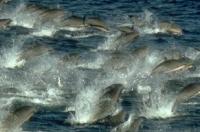 |
 Distribution Map
Distribution Map(Click for larger version) |
Fraser's Dolphin
|
 A School of Fraser's Dolphins
A School of Fraser's Dolphins
From the NUS Dolphin Study Group Etienne Douaze <douaze@dsg.sbs.nus.edu.sg Permission obtained on 30 July 1998, Email message. |
Fraser's dolphin, sometimes called the short-snouted whitebelly dolphin or the Sarawak dolphin, is known from tropical waters worldwide. Its primary habitat seems to be the tropical Pacific ocean, but isolated populations can also be found near Sri Lanka and South Africa. The natural history of this species is almost completely unknown. Fraser's dolpins appear to eat shrimp, fish otoliths, cephalodpods and isopods. They do not dive deeply to feed. Schools are rather large, on the order of several hundred, and have been seen mixed with melon-headed whales. When pursued, schools do not easily split apart. Fraser's dolphin is a somewhat obscur species, possibly resulting from the fact that they are shy of boats.
The dorsal surface of Fraser's dolphin is dark gray, while the ventral surface is lighter and has a series of lateral stripes. Various descriptions have indicated some variation in color, ranging from dark grayish blue to brownish. The dorsal fin is small, and both the dorsal fin and the flippers are dark. The beak is more clearly defined than that of the genus Lagenorhynchus, but is far shorter than Stenella and Delphinus. It is possible to confuse this species with the striped dolphin. One can distinguish it by the smaller appendages and overall size, as well as the somewhat different coloration. There are no threats to this species that threaten to deplete the population, althogh some direct and incidental coastal taking is reported.
|
|
|
|
|
![]()
Bibliography
Baker, Mary L. Whales, Dolphins, and Porpoises of the World. New York: Doubleday & Company, Inc., 1987.
Carwardine, Mark. Eyewitness Handbooks: Whales, Dolphins, and Porpoises. New York: Dorling Kindersley Ltd., 1995.
Ellis, Richard. Dolphins and Porpoises. New York: Alfred & Knopf, Inc., 1982.
Klinowska, Margaret. Dolpins, Porpoises, and Whales of the World: The IUCN Red Data Book. Gland, Switzerland: World Conservation Union, 1991.
|
© 1998 Thinkquest Team 17963 <17963@advanced.org Modified: 29 August 1998, Created: 9 August 1998 |
